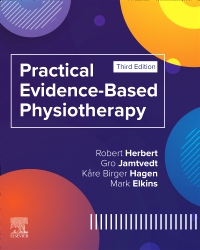
Practical Evidence-Based Physiotherapy - Elsevier eBook on VitalSource, 3rd Edition
Elsevier eBook on VitalSource

Written by an international team of experts and comprehensively updated in its third edition, the book considers how different sorts of evidence can be used to guide physiotherapy practice. It covers emerging methods, the use of both quantitative and qualitative research, and how to use online resources.
This book will help physiotherapy students and practitioners acquire fundamental skills of evidence-based practice and clinical reasoning, quickly find and use evidence in their work, and stay up to date with the latest evidence.
-
- Written specifically for physiotherapists, with physiotherapy examples throughout
- Clear explanations, research terminology explained
- Suitable for all levels of expertise - highlighted critical points and text box summaries (basic), detailed explanations in text (intermediate) and footnotes (advanced)
- Detailed strategies for searching physiotherapy-relevant databases, including the DiTA database
- Extensive consideration of clinical practice guidelines
- Emerging methods such as stepped-wedge trials, network meta-analysis, mixed methods reviews and process evaluations
- Widely referenced throughout
-
1. Evidence-Based Physiotherapy
2. What Do I Need to Know?
3. What Constitutes Evidence?
4. Finding the Evidence
5. Can I Trust This Evidence?
6. What Does This Evidence Mean for My Practice?
7. Clinical Guidelines as a Resource for Evidence-Based Physiotherapy
8. When and How Should New Therapies Be Introduced Into Clinical Practice?
9. Making it Happen
10. Am I on the Right Track?


 as described in our
as described in our 